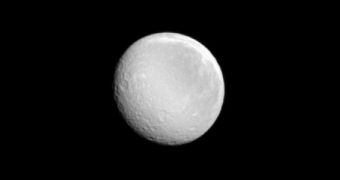Officials with the NASA Jet Propulsion Laboratory (JPL) in Pasadena, California, who manage the Cassini spacecraft currently in orbit around Saturn, have recently released this new image of the gas giant's second-largest moon, called Rhea. Unlike other photos of Saturnine moons, this one is fully illuminated by the Sun, revealing more details about the celestial body's terrain and landscapes.
With a diameter of around 1,527 kilometers (949 miles), Rhea is smaller than Titan, which is around 2,576 kilometers (1,600 miles) across. The image above shows almost the entire disk of the moon, centered on its Saturn-facing hemisphere. The extreme illumination from the Sun allowed Cassini to make out a host of features that were invisible from its previous vantage points.
The photo was snapped with the narrow-angle camera (NAC) instrument aboard Cassini, on September 10, 2013, while the spacecraft was flying around 1.6 million kilometers (990,000 miles) away from the moon. Due to this extreme distance, the resolution level is just 9 kilometers (6 miles) per pixel. NAC collected this view in optical wavelengths. North is up and 43 degrees to the left.
Less than 4 years ago, NASA scientists were able to discover an exosphere, a type of tenuous atmosphere, surrounding Rhea. Cassini has been studying Saturn's moons, rings, and the planet itself since achieving orbital insertion around this world, on June 1, 2004.

 14 DAY TRIAL //
14 DAY TRIAL //